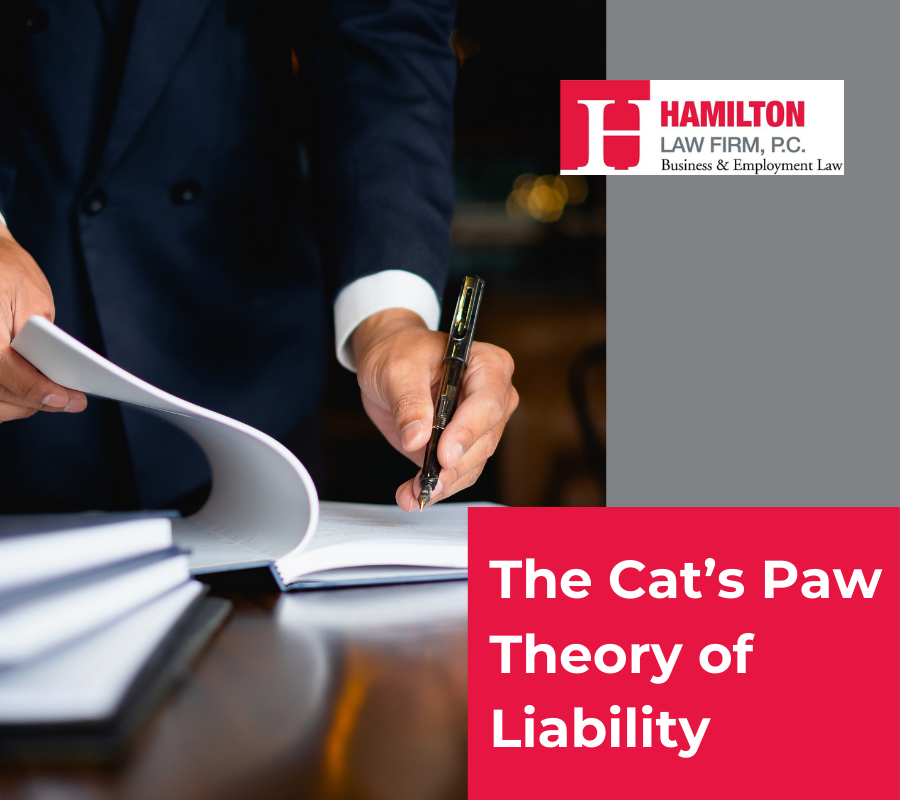The Case:
In a gender bias claim brought against the Township of Livingston, Michele Meade, Livington’s Township Manager, asserts that she was fired because of the Police Chief’s gender bias against working for a woman. As employers do, the Township argues that she was terminated for poor performance. Meade v. Twp. of Livingston, A-52-20 New Jersey Supreme Court, decided December 30, 2021. While the Supreme Court did not find this to be a Cat’s Paw case, they do a great job of explaining the theory of liability.
Ms. Meade was removed by Township Council in 2016 citing her performance issues, which allegedly resulted from her supervision over the Township’s Police Chief. Upon notifying Council of issues relating to the Police Chief’s performance, Ms. Meade was directed to take appropriate action to address those performance issues. One Councilmember, Michael Silverman, noted at a meeting in December 2014 that “Michele would not be having this problem if her name was Michael.” The Mayor also suggested that the Police Chief didn’t like reporting to Meade and should report to the Mayor instead. Despite the acknowledgment of the Police Chief’s gender bias issues, the Council voted to remove Meade from her position in November 2016.
After her termination, the Township conducted a search to replace her and hired a man despite the availability of female candidates. Meade was the only female manager in Livingston Township’s history and the Police Chief “voluntarily retired” following her termination. Meade sued in 2017 stating that the Township terminated her and replaced her with a male to “appease a sexist male Police Chief.”
The lower courts dismissed Meade’s claims, finding that the discrimination came from below her, not above, and hence, she could not maintain a gender bias claim against the Township. The New Jersey Supreme Court disagreed and reversed that decision, allowing Meade’s claims against Livingston to proceed.
So, Why is this Case Noteworthy?
The Supreme Court found that a reasonable jury could find that the alleged performance issues raised against Meade, arising from her failure to properly manage the Police Chief, were because of his gender bias, and further, that her termination and replacement with a male manager, was prima facie evidence of gender bias.
The New Jersey Supreme Court discusses the “Cat’s Paw” theory of liability here. While they find that this is not a Cat’s Paw case, the Supreme Court explained that principle as “a situation in which a biased subordinate, who lacks decision making power, uses the formal decision maker as a dupe in a deliberate scheme to trigger a discriminatory employment action.” Quite often, an employer will use a “decision maker” who fits the same protected category (race, age, gender) to claim that the termination decision could not have possibly been discriminatory because it was done by someone within the same classification. You may see a different manager being brought in to handle the termination. You may be told that the decision to terminate was taken by someone who had nothing to do with your job responsibilities and had no oversight over your performance. These should serve as red flags to you. Out of the ordinary behavior is usually an indicator that the employer realizes that they have some exposure in their termination decision and are trying their best to diffuse your arguments even prior to the termination event. While it’s a nice try by the company’s attorney, the Cat’s Paw Theory of liability allows your claim to proceed.
The Bottomline: If you start to see changes in your reporting structure as the discrimination, harassment, retaliation fact pattern is unfolding or as you are being written up for alleged performance issues, it’s time to consult an attorney.


